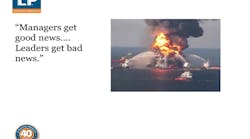Showing a photograph of a flaming BP Deepwater Horizon drilling platform, LP Corporate Health and Safety Director Keith Harned noted, “Managers get good news. Leaders get bad news.”
Harned noted that the day of the Deepwater Horizon explosion, which killed 11 workers, injured 16 and created a massive environmental catastrophe, senior managers had been on the rig, congratulating the operators and workers for a low rate of personal injuries. The managers were there to share in the good news, said Harned. What they didn’t want to hear about were all the ongoing mishaps and shortcuts that didn’t result in immediate injuries but did result in the explosion and massive oil spill.
A leader would want to hear everything, said Harned. A leader would ask: “How are you doing correcting those things we know can hurt people?”
LP wasn’t always world-class in safety, Harned admitted. In 2005, 115 employees were injured on the job. By 2010, that number had fallen to 34 and in 2013, that number is 19, which does not satisfy Harned. “That’s 19 too many folks who have been hurt on my watch. My watch!” he said.
Still, the numbers are going in the right direction, as are the workers’ compensation costs – from $8 million in 2000 to $600,000 in 2010 and still falling.
In early 2005, Harned and other company leaders embarked on making safety a core value. “There were no sacred cows,” he said. “Everything – every incident, every injury – had to have a systemic cause.”
The program has a number of drivers, said Harned, including:
- Formalizing safety and health efforts (Vision/Principles, Life Saving Rules)
- Keeping senior management informed
- Beginning all company meetings with a safety message/contact
- Move from “goals” to “targets”
- More interactions with plants and senior managers
- Recognition of positive performance (celebrating success)
- Driving to root cause and communicating the results to managers and employees
- More reporting and investigating of near misses (open atmosphere for reporting)
- More use of leading indicators
- Plant-based ownership
- From zero tolerance to life-saving rules
In particular, Harned focused on the importance of a good near miss reporting system and follow up, noting that if BP and its contractors and partners had done that, “all the small things that contribute to a big thing” might have been avoided.
A focus on leading indicators, such as near miss reporting, employee engagement, employee involvement in goal setting and improvements and leadership from management are helping drive the LP program forward. “Nobody is leaving here and driving away while only looking in the rearview mirror,” noted Harned. “You need to look ahead. That’s the value of leading indicators.”
His goal is to reach the point where “trailing indicators will be a glance in the rearview mirror.”
He cautioned that safety leaders should try to examine their safety and production processes with new eyes and encourage employees to do the same, because over the years, “several hundred things might have become an acceptable practice at your facility, even though they are not safe practices.”
By doing these things, LP “has taken safety from one of the things we do to safety is how we do everything we do,” said Harned.
As a bonus, Harned said that the more safety performance improved at the company, the more production records were set.
